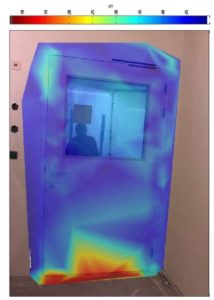Air, smoke and gas tightness are important in relation to:
- the conservation of fuel and energy (in buildings and temperature controlled spaces)

- optimalisation of the comfort (controlling the flow in passive houses, temperature and acoustic insulation,..)
- improving fire safety (smoke leak prevention)
- pollution prevention (ie leaking tanks, spreading of noxious gases,..)
- eliminating smell disturbance in offices (near processing plants, in refineries,..)
Upon request we perform customized non-destructive and reliable ultrasound measurements for:
1- Land based applications:
- tightness testing of (fuel)tanks:above ground tanks (with visualisation of the leak location and intensity)
- underground tanks (no visualisation possible, but certainty of no leakage)
- air tightness or permeability testing of buildings and residential houses:
- on prefab structures, as a quality control before leaving the factory
- as a building prescan, to resolve leaks at an early stage (while they can still be rectified in an economical way)to measure compliance with fire security (smoke
- leak detection on pipes and tanks containing pressurized air or gasses
- water-wind-and noise testing in the automotive sector…
2- Off-shore structures and ship applications:
- general tank tightness testing
- testing of water and weather tightness of marine structures and equipment like:
- watertight doors and bulkheads
- access hatches and bulk carrier hatch covers (to avoid claims and damage to cargo)
- portholes and windows
- electric cable and pipe penetrations,…
- Insulated immersion suits
- leak detection on pipes and tanks containing pressurized air or gasses
- thermal and acoustic tightness testing on pleasure boats and commercial yachts
- …
Were possible, our reports contain a still of the visualisation of location and the extend of the detected leak(s), similar to the IR (thermal) detection method.
Remarks:
-The used ultrasound methode is a convenient alternative to the more cumbersome and time consuming IR techniques, blowerdoor testing, water-or smoke testing, hose testing,…
-Testing on marine structures is done with type approved equipment. Protocols used are accepted by several P&I clubs and IACS members. Call us for info.
Info on Passive Houses : Passive House Institute
Hatchcover testing , Risk Focus
Pictures: courtesy of ypemedia and Ultragraphyx®
